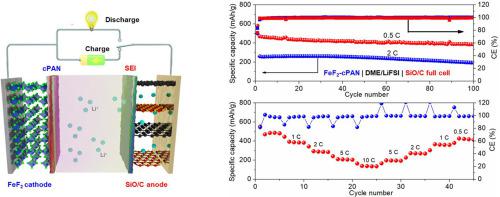Energy Storage Materials ( IF 18.9 ) Pub Date : 2023-04-15 , DOI: 10.1016/j.ensm.2023.102779 Yong Su , Shuangxu Liu , Dingding Zhu , Yang Luo , Xuedong Zhang , Jitong Yan , Jingzhao Chen , Lin Geng , Baiyu Guo , Hui Li , Qiushi Dai , Hongjun Ye , Jingming Yao , Yunna Guo , Gang Wang , Yongfu Tang , Liqiang Zhang , Congcong Du , Jianyu Huang , Qiao Huang

|
Iron-based fluorides (IBFs, typically FeF3 and FeF2) are potential next generation high energy density cathodes for lithium-ion batteries (LIBs) due to their high specific capacity, cost effectiveness and crustal abundance. However, IBFs decompose electrolyte violently which impedes their practical implementation in LIBs. Herein we report a strategy to embed FeF2 nanoparticles in an interconnected cyclic polyacrylonitrile (cPAN) network to passivate the cathode/electrolyte interface. Moreover, cPAN affords strong adhesion to both the FeF2 nanoparticles and the current collector, essentially acting as a binder that is superior to polyvinylidene fluoride (PVDF). Cryo-transmission electron microscopy reveals that the amorphous cPAN was uniformly coated on the FeF2 surface with a thickness of 5 nm, acting as an effective (cathode electrolyte interphase) CEI layer that inhibited the growth of excessive CEI, thus achieved stable cycling in lean electrolyte. When paired with the high capacity SiO/C anode, the FeF2-cPAN|SiO/C full cell delivered a capacity of 400 mAh/g after 100 cycles at 0.5C. Density functional theory (DFT) calculation indicates that the cPAN is inert to the electrolyte, thus suppresses the catastrophic electrolyte decomposition caused by FeF2. DFT further suggests that the existence of vacancies on the carbon surface will cause H transfer reaction of the solvent, leading to the degradation of the electrolyte. This study provides a viable technology to enable high energy density FeF2 cathode-based LIBs for energy storage applications.
中文翻译:

基于表面工程的无粘合剂高性能 FeF2 阴极基全电池的冷冻透射电镜研究
铁基氟化物(IBF,通常为 FeF 3和 FeF 2)由于其高比容量、成本效益和地壳丰度而成为锂离子电池 (LIB) 的潜在下一代高能量密度阴极。然而,IBF 会剧烈分解电解质,这阻碍了它们在 LIB 中的实际应用。在此,我们报告了一种将 FeF 2纳米粒子嵌入互连的环状聚丙烯腈 (cPAN) 网络中以钝化阴极/电解质界面的策略。此外,cPAN 对 FeF 2纳米粒子和集电器,本质上充当优于聚偏二氟乙烯 (PVDF) 的粘合剂。冷冻透射电子显微镜显示,非晶cPAN均匀地涂覆在FeF 2表面,厚度为5 nm,作为有效的(阴极电解质界面)CEI层抑制了过量CEI的生长,从而实现了贫油中的稳定循环电解质。当与高容量 SiO/C 阳极配对时,FeF 2 -cPAN | SiO/C 全电池在 0.5C 下循环 100 次后可提供 400 mAh/g 的容量。密度泛函理论 (DFT) 计算表明 cPAN 对电解质呈惰性,从而抑制了由 FeF 2引起的灾难性电解质分解. DFT进一步表明,碳表面空位的存在会引起溶剂的H转移反应,导致电解质的降解。该研究提供了一种可行的技术,可实现用于储能应用的高能量密度 FeF 2阴极基锂离子电池。











































 京公网安备 11010802027423号
京公网安备 11010802027423号